英语报刊阅读教程unit 1 Culture, Education and Religion
- 格式:ppt
- 大小:742.00 KB
- 文档页数:72
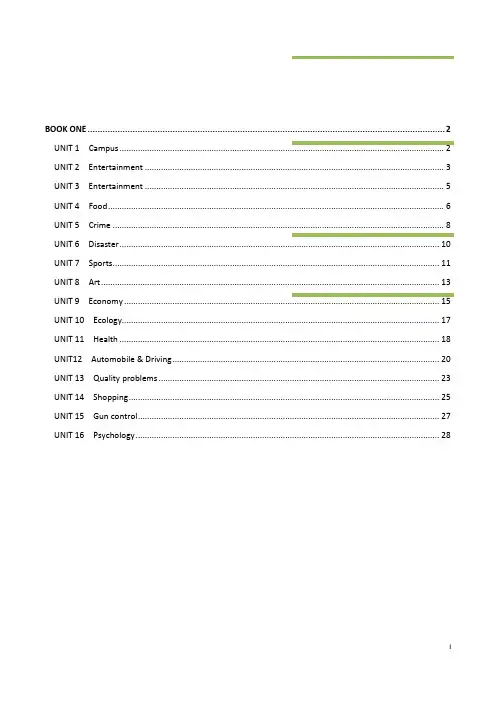
BOOK ONE (2)UNIT 1 Campus (2)UNIT 2 Entertainment (3)UNIT 3 Entertainment (5)UNIT 4 Food (6)UNIT 5 Crime (8)UNIT 6 Disaster (10)UNIT 7 Sports (11)UNIT 8 Art (13)UNIT 9 Economy (15)UNIT 10 Ecology (17)UNIT 11 Health (18)UNIT12 Automobile & Driving (20)UNIT 13 Quality problems (23)UNIT 14 Shopping (25)UNIT 15 Gun control (27)UNIT 16 Psychology (28)BOOK ONEUNIT 1 CampusI.Vocabulary Builder1.Definition1)chaotic: extremely disorganized; badly organized; be in mess2)primary: main; most important; key; major; chief; prime; principal3)seduce: attract; tempt4)highlight: the most important, interesting, or enjoyable part of something such as a holiday,performance, or sports competition5)reluctant: unwilling6)compelling: very interesting or exciting, so that you have to pay attention7)reveal: show; indicate8)mainstream: accepted by or involving most people in a society; normal; ordinary9)critical: important; crucial10)evolution: a long, gradual process during which something develops and changes, usuallybecoming more advanced; a gradual change and development2. Terms translation1) a bipartisan consensus2)high school diploma3)drop-out rate4)college wage premium5)the K-12 system6)more academically rigorous7)well-rounded citizens8)certification tests9)career and technical education3. Blank filling1) persevered 2) persisted 3) insisted 4) insisted 5) persevere6) agony 7) adversity 8) torment 9) plight 10) assure/reassure11) insure/ensure 12) insure 13) insure/ensure 14) assured/reassuredII.Translation1.选择圣路易斯的华盛顿大学是个不错的决定,但真正让我享受到理想大学生活的,(不是大学本身)是我到了大学后作的一些决定。

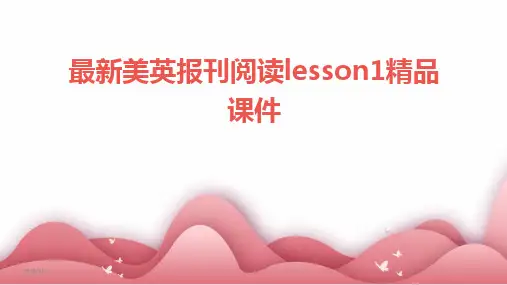

张健英语报刊阅读教程课后答案1、The reason I didn't attend the lecture was simply _____ I got a bad cold that day. [单选题] *A. becauseB. asC. that(正确答案)D. for2、The language school started a new()to help young learners with reading and writing. [单选题] *A. course(正确答案)B. designC. eventD. progress3、He didn't allow _____ in his room. Actually he didn't allow his family _____ at all. [单选题] *A. to smoke; to smokeB. smoking; to smoke(正确答案)C. to smoke; smokingD. smoking; smoking4、—______ do you play basketball?—Twice a week.()[单选题] *A. How often(正确答案)B. How muchC. How manyD. How long5、Alice is fond of playing ____ piano while Henry is interested in listening to ___ music. [单选题] *A. the, /(正确答案)B. the, theC. the, aD. /, the6、Jack can speak Japanese, and his brother can _______ speak Japanese. [单选题] *A. tooB. also(正确答案)C. eitherD. as well7、( ) ----Would you like___ tea? ----No, thanks. I have drunk two____. [单选题] *A. any, bottles of orangeB. some, bottles of orange(正确答案)C. many, bottles of orangesD. few, bottle of oranges8、How beautiful the flowers are! Let’s take some _______. [单选题] *A. photos(正确答案)B. potatoesC. paintingsD. tomatoes9、You could hardly imagine _______ amazing the Great Wall was. [单选题] *A. how(正确答案)B. whatC. whyD. where10、His understanding made a deep impression_____the young girl. [单选题] *A.on(正确答案)B.inC.forD.with11、He prefers to use the word “strange”to describe the way()she walks. [单选题] *A. in which(正确答案)B. by whichC. in thatD. by that12、12.That is a good way ________ him ________ English. [单选题] *A.to help;forB.helps;withC.to help;with(正确答案)D.helping;in13、The house is well decorated _____ the disarrangement of a few photos. [单选题] *A. exceptB. besidesC. except for(正确答案)D. in addition to14、I can’t hear you _______. Please speak a little louder. [单选题] *A. clearly(正确答案)B. lovelyC. widelyD. carelessly15、26.—Mary, is this your pen?—No, it isn't. ________ is black. [单选题] * A.MyB.IC.MeD.Mine(正确答案)16、Miss Smith is a friend of _____. [单选题] *A. Jack’s sister’s(正确答案)B. Jack’s sisterC. Jack sister’sD. Jack sister17、_______ a busy afternoon! [单选题] *A. HowB. What(正确答案)C. WhichD. Wish18、The organization came into being in 1 [单选题] *A. 开始策划B. 进行改组C. 解散D. 成立于(正确答案)19、Though the _____ drama is wonderful, I guess most audiences will be tired as it is too long. [单选题] *A. four-hour(正确答案)B. four hoursC. four-hoursD. four-hour's20、29.There is a book in your left hand. What’s in your ___________ hand? [单选题] *A.the othersB.other (正确答案)C.another21、39.—What do you ________ my new dress?—Very beautiful. [单选题] *A.look atB.think aboutC.think of(正确答案)D.look through22、In the past, Mary _______ listening to music in her spare time. [单选题] *A. will likeB. likesC. likeD. liked(正确答案)23、She and her family bicycle to work, _________ helps them keep fit. [单选题] *A. which(正确答案)B. whoC.itD. that24、Mary, together with her children ,_____ some video show when I went into the sitting room.A. were watchingB. was watching(正确答案)C. is watchingD. are watching25、—Would you like some milk?—Yes, just _____, please. [单选题] *A. a little(正确答案)B. littleC. a fewD. few26、I don't know the man _____ you are talking about. [单选题] *A. who'sB. whose(正确答案)C. whomD. which27、1.________my father ________ my mother is able to drive a car. So they are going to buy one. [单选题] *A.Neither; norB.Both; andC.Either; orD.Not only; but also(正确答案)28、We are living in an age()many things are done by computer. [单选题] *A. thatB. whichC. whyD. when(正确答案)29、There are still some wild tigers alive. [单选题] *A. 聪明的B. 凶恶的C. 野生的(正确答案)D. 珍贵的30、Just use this room for the time being ,and we’ll offer you a larger one _______it becomes available [单选题] *A. as soon as(正确答案)B unless .C as far asD until。

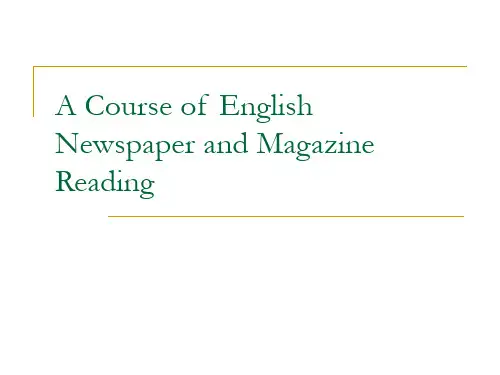
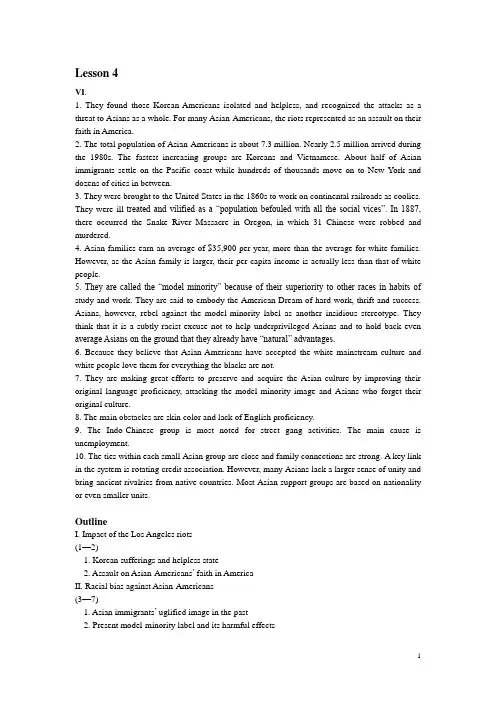
Lesson 4VI.1. They found those Korean-Americans isolated and helpless, and recognized the attacks as a threat to Asians as a whole. For many Asian-Americans, the riots represented as an assault on their faith in America.2. The total population of Asian-Americans is about 7.3 million. Nearly 2.5 million arrived during the 1980s. The fastest increasing groups are Koreans and Vietnamese. About half of Asian immigrants settle on the Pacific coast while hundreds of thousands move on to New York and dozens of cities in between.3. They were brought to the United States in the 1860s to work on continental railroads as coolies. They were ill-treated and vilified as a “population befouled with all the social vices”. In 1887, there occurred the Snake River Massacre in Oregon, in which 31 Chinese were robbed and murdered.4. Asian families earn an average of $35,900 per year, more than the average for white families. However, as the Asian family is larger, their per capita income is actually less than that of white people.5. They are called the “model minority” because of their superiority to other races in habits of study and work. They are said to embody the American Dream of hard work, thrift and success. Asians, however, rebel against the model-minority label as another insidious stereotype. They think that it is a subtly racist excuse not to help underprivileged Asians and to hold back even average Asians on the ground that they already have “natural” advantages.6. Because they believe that Asian-Americans have accepted the white mainstream culture and white people love them for everything the blacks are not.7. They are making great efforts to preserve and acquire the Asian culture by improving their original language proficiency, attacking the model minority image and Asians who forget their original culture.8. The main obstacles are skin color and lack of English proficiency.9. The Indo-Chinese group is most noted for street gang activities. The main cause is unemployment.10. The ties within each small Asian group are close and family connections are strong. A key link in the system is rotating credit association. However, many Asians lack a larger sense of unity and bring ancient rivalries from native countries. Most Asian support groups are based on nationality or even smaller units.OutlineI. Impact of the Los Angeles riots(1—2)1. Korean sufferings and helpless state2. Assault on Asian-Americans’ faith in AmericaII. Racial bias against Asian-Americans(3—7)1. Asian immigrants’ uglified image in the past2. Present model-minority label and its harmful effects3. Resentment against Asians for their success and behavior4. Asians’ isolation from the rest of the society5. Boycotts and assaults on Asian businessesIII. American culture’s influence(8—12)1. Fast increase of Asian immigrants wishing to realize the American Dream2. Second generation’s tendency to abandon Asian values3. Identity crisis resulting from two cultures’ pull4. Young people’s efforts to preserve the original culture5. The least assimilated group: Chinatown residentsIV. Discrimination against Asians(13—17)1. Hurdles for assimilation2. Glass ceiling3. UnemploymentV. Similarities and differences between Asians and Blacks(18—21)1. Similar sufferings2. Similar spiritualities3. Asian-Americans’ less difficulty in shrugging off the legacy of discrimination4. First-generation Asian immigrants’ incredibly hardworking and thrifty characterVI. Asians’ ties and political status(22—24)1. Close community ties2. Lack of a larger sense of unity3. Underrepresentation at all government levelsVII. Author’s view concerning the development of Asians’ sentiment(25) Unlikely to become a wider political movementLesson 6Answers to the QuestionsV. 1. B 2. B 3. B 4. C 5. DVI.1. Because they regard First Amendment freedom as essential American rights and will not allow any restriction on it.2. Because it holds the view that the reform will place restriction on individual rights and therefore should be fiercely resisted.3. Because the situation is not the same as before. In the 1950s, McCarthy and his inquisitors trampled the free expression of left-wing view; and so for the next two decades or so it was essential to defend the principle of free speech at every opportunity. Now the free speech is not in jeopardy, it should not be rigidly defended.4. Mr. Neuborne holds that in modern political campaign rich candidates flood voters with commercials and propaganda of every kind, so that others have no chance of attracting attention. Poor candidates may enjoy the right to speak, but not the hope that everyone will hear what theyhave to say. To give them a hearing, he suggests that the speech of rich candidates be limited.5. The authors mean that the situation now is different from that of the 1960s. Americans should not abide by the same principle in spite of the change of time. In the 1960s heyday, the ACLU was absolutely correct in upholding citizens’ rights against the police and other authorities. This was because they did not reflect the inte rests of America’s black minority. However, all that has now changed: many policemen, and police chiefs, are black, as are many mayors. If these leaders, reflecting the wishes of their constituencies, choose to adopt tough measures to fight crime, the ACLU should not presume to second-guess them. It’s time to adopt a different attitude.6. The ACLU’s rigid defence of rights ends up favoring the strong more than the weak.7. He thinks that America’s free speech has a price. Though America has been one of the freest countries in the world, it is one of those in which the gap between the rich and poor is the starkest.OutlineI. The burial of the campaign finance reform and its implications(1)II. Two sides’ views on the reform(2)1. Opponents’ view2. Majority’s viewIII. American public’s qualified support for free speech(3—5)1. Firm belief in the first amendment2. Strong support for the campaign finance reform3. Deep split within the ACLU over the campaign financeIV. Criticism of the ACLU’s rigid defence of rights(6—11)1. Burt Neuborne’s view on the ACLU’s line on campaign spending2. Tracey Meares and Dan Kahan’s criticism of the ACLU’s other issuesV. Author’s comment(12) Liberty has a price.Lesson 7Answers to the QuestionsV. 1. D 2. C 3. D 4. D 5. BVI.1. It indicates that Microsoft corp. has tight control over the software business.2. The present honeymoon will not last long. The industry does not speak with one voice. At the same time, their success has greatly damaged the interests of other industries. So there will be troubles ahead. Besides this, there’s also potential for a huge culture clash. A lot of Silicon Valley types don’t realize the importance of politics and have disdain for government.3. President Clinton promised to keep the Internet tax-free for now and Hewlett Packard Co. won approval to export sophisticated cryptography chips. The 1986 semiconductor trade agreement was signed to stop the dumping of Japanese chips in the US and set market-share goals for US chips in Japan.4. The industry believes that government should do what it needs to do but leave them alone. The software tycoons have little patience for bureaucratic oversight and tend to be uncompromising. The hardware tycoons are willing to look for compromise.5. They are: easing immigration restriction; securities-litigation reform and ending export limit of encryption technology.6. The Internet and electronic commerce have been rearranging the business landscape—changing how Americans buy everything. They are spreading into all sorts of digital services, from entertainment to online banking to telephony.7. Because high-tech leaders have realized that the industry’s future is less about technology and more about policy.OutlineI. Close contact between high tech industry and Washington politicians(1—2)1. Specific example: Bill Gates and Scott G. McNealy’s attendance at the March 3 hearing of the Senate Judiciary Committee2. Increasing contact between high tech industry and Washington policy makersII. Reasons for the close relationship(3—6)1. High tech industry’s fast expansion and the appearance of more issues2. Politicians’ strong interest in the job growth industry3. Increasing conflicts between high tech industry and other industries4. High tech industry’s urgent need for solution to many problemsIII. Relationship between high tech industry and government(7—11)1. Good relationship at present2. Difficulties in maintaining the honeymoon3. Need for high tech new executives to learn lobbyingIV. Efforts made by high tech companies at lobbying(12—14)1. Computer companies’ fight for a high-definition TV format2. The establishment of Washington offices3. Crusade to fight alleged Japanese dumping of computer chipsV. Problems with the high tech industry(15—16)1. Lack of unity2. Little patience for bureaucratic oversightVI. Objectives of the high tech executives(17—18)1. Easing immigration restriction and securities litigation reform2. Ending limit on the export encryption technologyVII. Prospects(19) High tech executives will quickly learn how to play the Washington political gameLesson 12Answers to the QuestionsV. 1. A 2. D 3. D 4. C 5. BVI.1. The market situation of the sales in the United States is much better than ever before. Many bookstores report increases of over 30%.2. America’s bookstores offer a rich diversity of Bibles to suit people’s different needs and comprehension levels. The 270 stores in the Family Christian Stores chain might carry 200 different titles. Customers now have more choices in format, bindings, boxing and pricing. All new Bibles claim improved scholarship, better readability and more relevance.3. The advance of technology has made it possible to publish more quickly and less expensively. Therefore, it has helped to speeden new Bible production and shorten the shelf life of Bibles.4. In order to meet readers’ different needs, publishers produce specialty Bibles and Bibles with notes and comments.5. The initialism NIV stands for the New International Version.6. The notes and comments in the new Bible would produce the adverse effects of leading the reader off the right page theologically and remaking God in the writer’s own image.OutlineI. Fast increase of Bible sales(1—5)II. Rich diversity of Bible versions and variations(6—17)1. More choices in bindings, boxings and pricing2. Different kinds of Bibles serving different purposes3. Different Bibles claiming improved scholarship and readability4. An explosion of format choicesIII. Reasons for the rich diversity(18—25)1. Advance of technology2. Bible companies’ desire for their market shares3. Customers’ wish for specialty versions suiting their specific needsIV. Possible adverse effects of the notes and comments(26—35)1. Leading the reader off the right page theologically2. Remarking God in one’s own imageLesson 15Answers to the QuestionsV. 1. B 2. D 3. B 4. B 5. AVI.1. Americans transfer less money among themselves for such things as social security and welfare.2. It is the measure of “fiscal drag”—the burden taxes place upon an economy.3. It refers to funds that go from one citizen’s pocket to another’s with the government as intermediary.4. High-tax, high-transfer countries tend to be culturally cohesive. America is a melting pot. It is a more diverse society. People are reluctant to contribute to the public spending.5. Lower taxes. More services and more spending.6. They would shoulder higher taxes if they could be sure that doing so would make life better for themselves, their children and their children’s children. A great ma jority would pay more if they could be guaranteed the money would go to education or health insurance or even housing for the homeless. They are willing to pay for the direct and visible services.OutlineI. American’s tax load compared with people of other countries(1—3)1. Lighter load according to OECD’s finding2. More complaints about taxes according to opinion polls3. Author’s view on OECD’s findingII. Similarities and differences between America and other countries in taxes(4—9)1. Similaritya. Allocation of similar proportion of GDP to governmentb. Effect of the allocation on economy: fiscal dragc. US tax payers’ strong sense of fiscal drag2. Difference: US less transfer paymentsa. America’s capability to increase transfer paymentsb. Reasons for US less transfer paymentsUS less cultural cohesion caused by the society’s diversity;Government’s less spending for infrastructureIII. Public’s sentiment over taxes(10—12)1. Willingness to pay more for worthwhile causes such as education and pollution control2. Hatred for bureaucrats’ waste of taxpayers’ money3. Tendency to want it both ways: lower taxes, but more servicesResult: huge federal deficitLesson 17Answers to the QuestionsV. 1. C 2. D 3. C 4. D 5. DVI.1. Alcohol poisoning caused Wynne’s death. The autopsy of Wynne found that he had a blood alcohol level six times the amount at which the state considers a person intoxicated.2. Excessive drinking among college students has been blamed for at least six deaths in the year before the writing of the article. It affects not only the bingers but also fellow students, who are more likely to report lost sleep, interrupted studies and sexual assaults on campuses with high binge-drinking rates. Sometimes it may cause riots.3. The most important factor is the campus culture encouraging students to drink, and drink heavily. At many colleges, school life is still synonymous with alcohol-lubricated gatherings. College newspapers are filled with alcohol-related ads. On many campuses, bars send shuttle buses to round up students.4. The act of raising the legal drinking age from 18 to 21 can not solve the problem. Many drink at private parties off campus, with an older student buying the alcohol. Bars’enforcement of the drinking age is often lax, false IDs are common, and legal-age friends are often willing to buy the drinks and bring them back to the table. Instead of drinking in well-monitored settings, the young often experiment in private homes and bars, where there are few checks in place to deter dangerous practices. Research suggests that making alcohol illegal may give it an illicit thrill for younger drinkers. So raising the age may have made the binge problem even worse.5. To solve the binge problem, many colleges hand out literature and hold workshops to educate students about responsible drinking. In addition, they penalize campus groups that sponsor reckless parties.6. No, it’s far from enough just to ban alcohol on campus, for it does nothing about the excessive drinking off-campus. So, colleges should work with the larger community to ensure that students cannot abuse alcohol at private homes and bars.OutlineI. Specific example: Wynne’s death of alcohol poisoning(1)II. General situation: Pervasive binge drinking on campuses(2—3)1. A common problem with most schools2. Huge yearly consumption of alcohol3. Harmful effects on the bingers and fellow studentsIII. Causes for the campus binge problem(4—5)1. Binge-encouraging culture: alcohol-lubricated gatherings; college newspapers’advertising; bars’ shuttle-bus service2. Off-campus wide-availability and high promotion of alcoholIV. Measures taken by many colleges to solve the binge problem(6—7)1. Education through literature and workshops2. Punishment for campus groups for sponsoring reckless parties3. Ban on alcohol consumption on campusesV. Author’s recommended measures(8—9)1. Working with the larger community to stop off-campus alcohol abuse2. Encouraging on-campus responsible drinking for those of legal drinking ageLesson21Answers to the QuestionsV. 1. B 2. C 3. D 4. A 5. BVI.1. He took two of his father’s guns from an unlocked cabinet and a third from a family car. He had learnt to fire weapons from his father.2. He means that Barry Loukaitis’ shooting in many respects showed the way in which America’s school yard killings would occur. More recent school killings followed the pattern of Barry Loukaitis’ shooting.3. The violent pop culture predisposed kids to violent behavior. It produced a profound cultural influence pulling kids into a world where violence is a perfectly normal way to handle emotions.4. It shows a very serious problem: American juveniles are becoming violent, callous andremorseless. More kids have mental disorders and their mental problems occur earlier.5. Most earlier killings were gang-related, or they were stabbings involving money or a girl friend. However, most recent killings were shootings done by kids with mental troubles. The victims were chosen at random.6. Yes, they gave ample warning signs, often in detailed writings at school, of dramatic violent outbursts to come. However, adults never took the threats and warning signs seriously. They simply overlooked them.7. Juvenile suicide rates have increased over the last four decades and have leveled off near their all-time highs. More than 1.5 million Americans under age 15 are seriously depressed.8. Because they were strapped for mental health counselors.9. Their parents or grandparents did not lock guns out of kids’ reach. Some of them even bought them guns and taught them how to use the guns.OutlineI. Specific example: Barry Loukaitis’ shooting on Feb. 2, 1996(1—4)II. Common traits of school yard killings after Barry’s shooting(5—14)1. Mental state: displaying problems2. Instruments for killing: easy access to guns3. Culture’s influence: immersion in gun culture and obsession with violent pop culture4. Signs of violence: showing ample signs, which, however, are overlookedIII. Striking changes of school yard killings in type over the last six years(15—27)1. Most earlier killings: gang-related stabbings; fights over money or a girl friend2. Most killings after Barry’s shooting: use of guns; random choices of victims; mental troubles3. Examples: Barry Loukaitis; an Alaskan boy; Luke Woodham in Mississippi; Michael Carneal in Kentucky; a 13-year-old boy in ArkansasIV. Analysis of the Causes(28—41)1. Mood disorders happening earlier & shortage of mental health counselors2. Easy access to guns: unlocked; parents’ teaching; holiday gifts; taking courses3. Pop culture’s influence: violent video shows and video games; gangster rap。
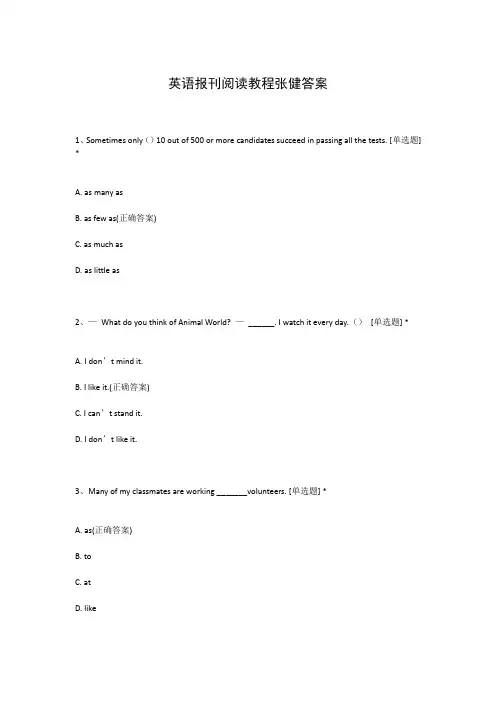
英语报刊阅读教程张健答案1、Sometimes only()10 out of 500 or more candidates succeed in passing all the tests. [单选题] *A. as many asB. as few as(正确答案)C. as much asD. as little as2、—What do you think of Animal World? —______. I watch it every day.()[单选题] *A. I don’t mind it.B. I like it.(正确答案)C. I can’t stand it.D. I don’t like it.3、Many of my classmates are working _______volunteers. [单选题] *A. as(正确答案)B. toC. atD. like4、My daughter is neither slim nor fat and she’d like a _______ skirt. [单选题] *A. largeB. medium(正确答案)C. smallD. mini5、72.—? ? ? ? ? ? ? ? ? ? ? ??—Yes, please. I want a sweater. [单选题] *A.How muchB.Can I help you(正确答案)C.Excuse meD.What will you take6、Wang Dong usually gets up at 6:00 _______ he can catch the early school bus. [单选题] *A. as ifB. so that(正确答案)C. untilD. after7、English is very important in our daily life. Never _______. [单选题] *A. give up itB. give it up(正确答案)C. give away itD. give it away8、More than one student_____absent from the class yesterday due to the flu. [单选题] *A.areB.hasC.isD.was(正确答案)9、My home is about _______ away from the school. [单选题] *A. three hundred metreB. three hundreds metresC. three hundred metres(正确答案)D. three hundreds metre10、Nuclear science should be developed to benefit the people_____harm them. [单选题] *A.more thanB.other thanC.rather than(正确答案)D.better than11、_______ win the competition, he practiced a lot. [单选题] *A. BecauseB. In order to(正确答案)C. Thanks toD. In addition to12、I paid twenty yuan _______ the book. [单选题] *A. offB. backC. for(正确答案)D. with13、28.—Where is Fujian Province?—It’s ________ the southeast of China. [单选题] * A.in (正确答案)B.onC.toD.at14、He _______ maths. [单选题] *A. does well in(正确答案)B. good atC. is well inD. does well at15、When we take a trip,we usually have to _______ a hotel. [单选题] *A. takeB. stayC. book(正确答案)D. bring16、The reason why I didn't attend the lecture was simply()I got a bad cold that day. [单选题] *A. becauseB. asC. that(正确答案)D. for17、She often _______ at 21: [单选题] *A. go to bedB. gets upC. goes to bed(正确答案)D. gets to18、The blue shirt looks _______ better on you than the red one. [单选题] *A. quiteB. moreC. much(正确答案)D. most19、She was seen _____ that theatre just now. [单选题] *A. enteredB. enterC. to enter(正确答案)D. to be entering20、I?have to?_______ my younger brother on Sunday. [单选题] *A. look after(正确答案)B. look upC. take careD. look out21、I always make my daughter ______ her own room.()[单选题] *A. to cleanB. cleaningC. cleansD. clean(正确答案)22、The city is famous _______ its beautiful scenery. [单选题] *A. for(正确答案)B. ofC. asD. to23、—Would you like some milk?—Yes, just _____, please. [单选题] *A. a little(正确答案)B. littleC. a fewD. few24、At nine yesterday morning, I ______ an English class while they ______ a PE class.()[单选题] *A. was having; were having(正确答案)B. had; hadC. was having; hadD. had; were having25、46.The pants look cool.You can ________. [单选题] *A.try it onB.try on itC.try them on(正确答案)D.try on them26、21 In a few years' time, there ________ thousands of trees on the hill. [单选题] * A.will haveB.will be(正确答案)C.are haveD.have27、43.How much did you ________ the man for the TV? [单选题] *A.pay(正确答案)B.takeC.spendD.buy28、I should like to rent a house which is modern, comfortable and _____, in a quiet neighborhood. [单选题] *A.in allB. after allC. above all(正确答案)D. over all29、I was astonished when I heard that Louise was getting married. [单选题] *A. 惊讶(正确答案)B. 气愤C. 高兴D. 想念30、On Mother’s Day, Cathy made a beautiful card as a ______ for her mother. [单选题] *A. taskB. secretC. gift(正确答案)D. work。
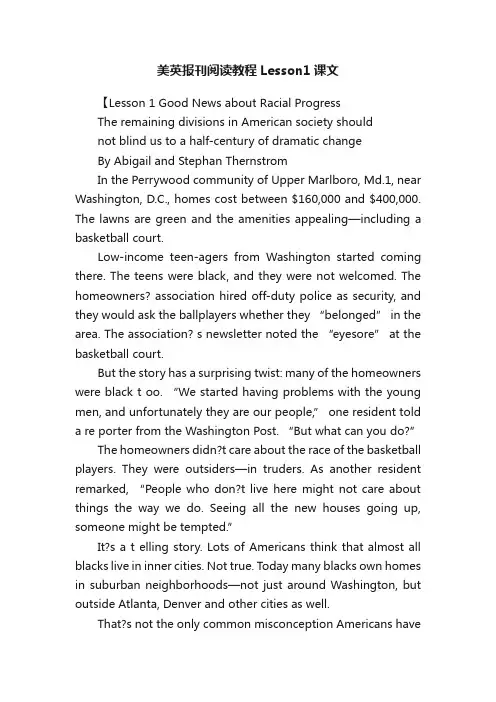
美英报刊阅读教程Lesson1课文【Lesson 1 Good News about Racial ProgressThe remaining divisions in American society shouldnot blind us to a half-century of dramatic changeBy Abigail and Stephan ThernstromIn the Perrywood community of Upper Marlboro, Md.1, near Washington, D.C., homes cost between $160,000 and $400,000. The lawns are green and the amenities appealing—including a basketball court.Low-income teen-agers from Washington started coming there. The teens were black, and they were not welcomed. The homeowners? association hired off-duty police as security, and they would ask the ballplayers whether they “belonged” in the area. The association? s newsletter noted the “eyesore” at the basketball court.But the story has a surprising twist: many of the homeowners were black t oo. “We started having problems with the young men, and unfortunately they are our people,” one resident told a re porter from the Washington Post. “But what can you do?”The homeowners didn?t care about the race of the basketball players. They were outsiders—in truders. As another resident remarked, “People who don?t live here might not care about things the way we do. Seeing all the new houses going up, someone might b e tempted.”It?s a t elling story. Lots of Americans think that almost all blacks live in inner cities. Not true. Today many blacks own homes in suburban neighborhoods—not just around Washington, but outside Atlanta, Denver and other cities as well.That?s not the only common misconception Americans haveab out race. For some of the misinformation, the media are to blame. A reporter in The Wall Street Journal, for instance, writes that the economic gap between whites and blacks has widened. He offers no evidence. The picture drawn of racial relations is even bleaker. In one poll, for instance, 85 percent of blacks, but only 34 percent of whites, agreed with the verdict in the O.J. Simpson murder trial. That racially divided response made headline news. Blacks and whites, media accounts would have us believe, are still separate and hostile. Division is a constant theme, racism another.To be sure, racism has not disappeared, and race relations could —and probably will —improve. But the serious inequality that remains is less a function of racism than of the racial gap in levels of educational attainment, single parenthood and crime. The bad news has been exaggerated, and the good news neglected. Consider these three trends:A black middle class has arrived. Andrew Young recalls the day he was mistaken for a valet at the Waldorf-Astoria Hotel in New York City. It was an infuriating case of mistaken identity for a man who was then U.S. ambassador to the United Nations.But it wasn?t so long ago that most blacks were servants—or their equivalent. On the eve ofWorld War II, a trivial five percent of black men were engaged in white-collar work of any kind, and six out of ten African-American women were employed as domestics.In 1940 there were only 1,000 practicing African-American lawyers; by 1995 there were over 32,000, about four percent of all attorneys.Today almost three-quarters of African-American families have incomes above the government poverty line. Many are inthe middle class, according to one useful index—earning double the government poverty level; in 1995 this was $30,910 for a two-parent family with two children and $40,728 for a two-parent family with four children. Only one black family in 100 enjoyed a middle-class income in 1940; by 1995 it was 49 in 100. And more than 40 percent of black households also own their homes. That? s a huge change.The typical white family still earns a lot more than the black family because it is more likely to collect two paychecks. But if we look only at married couples—much of the middle class—the white-black income gap shrinks to 13 percent. Much of that gap can be explained by the smaller percentage of blacks with college degrees, which boost wages, and the greater concentration of blacks in the South, where wages tend to be lower.Blacks are moving to the suburbs. Following the urban riots of the mid-1960s, the presiden-tial Kerner Commission14 concluded that the nation? s future was menaced by “accelerating segrega-tion”—black central cities and whites outside the core. That segregation might well blow the country apart, it said.It? s true that whites have continued to leave inner cities for the suburbs, but so, too, have blacks. The number of black suburban dwellers in the last generation has almost tripled to 10.6 million. In 1970 metropolitan Atlanta, for example, 27 percent of blacks lived in the suburbs with 85 percent of whites. By 1990, 64 percent of blacks and 94 percent of whites resided there.This is not phony integration, with blacks moving from one all-black neighborhood into another. Most of the movement has brought African-Americans into neighborhoods much lessblack15 than those they left behind, thus increasing integration. By 1994 six in ten whites reported that they lived in neighborhoods with blacks.Residential patterns do remain closely connected to race. However, neighborhoods have become more racially mixed, and residential segregation has been decreasing.Bigotry has declined. Before World Was ft, Gunnar Myrdal16 roamed the South researching An American Dilemma, the now-classic book that documented17 the chasm betwe en the nation?s ideals and its racial practices, hi one small Southern city, he kept asking whites how he could find “Mr. Jim Smith,” an African-American who was principal of a black high school. No one seemed to know who he was. After he finally found Smith, Myrdal was told that he should have just asked for “Jim.” That? s how great was white aversion to dignifying African-Americans with “Mr.” Or “Mrs.”Bigotry was not just a Southern problem. A national survey in the 1940s asked whether “Ne-groes shoul d have as good a chance as white people to get any kind of job.” A majority of whites said that “white people should have the first chance at any kind of job.”19. Such a question would not even be asked today. Except for a lunatic fringe18, no whites would sign on to such a notion.1920. In 1964 less than one in five whites reported having a black friend. By 1989 more than two out of three did. And more than eight often African -Americans had a white friend.21. What about the last taboo?20 In 1963 ten percent of whites approved of black-white dating; by 1994 it was 65 percent. Interracial marriages? Four percent of whites said it was okay in1958; by 1994 the figure had climbed more than elevenfold, to 45 percent. These surveys measure opinion, but behavior has also changed. In 1963 less than one percent of marriages by African- Americans were racially mixed. By 1993, 12 percent were.22. Today black Americans can climb the ladder to the top.21 Ann M. Fudge is already there; she?s in charge of manufacturing, promotion and sales at the $2.7-billion Maxwell House Coffee and Post Cereals divisions of Kraft Foods.22 So are Kenneth Chenault, president and chief operating officer at American Express23 and Richard D. Parsons, president of Time Warner, Inc.24 After the 1988 Demo-cratic Convention25, the Rev. Jesse Jackson26 talked about his chances of making it to the White House. “I may not get there,” he said “But it is possible for our child ren to get there now.”23. Even that seems too pessimistic. Consider how things have improved since Colin and Alma Powell27 packed their belongings into a V olkswagen28 and left Fort Devens, Mass., for Fort Bragg, N. C. “I remember passing Woodbridgc, Va.,” General Powell wrote in his autobiogra phy, “and not finding even a gas-station bathroom that we were allowed to use.” That was in 1962. In 1996 reliable polls suggest he could have been elected President.24. Progress over the last half-century has been dramatic. As Corctta Scott King wrote not long ago, the ideals for which her husband Martin Luther King Jr. died, have become “deeply embedded in the very fabric of America29.”From Reader?s Digest, March, 1998V. Analysis of Content1. According to the author, ___________A. racism has disappeared in AmericaB. little progress has been made in race relationsC. media reports have exaggerated the racial gapD. media accounts have made people believe that the gap between blacks and whites has become narrower2. What the Kerner Commi ssion meant by “accelerating segregation” was that __________A. more and more whites and blacks were forced to live and work separatelyB. more and more blacks lived in the central cities, and whites outside the coreC. more and more whites lived in the central cities, and blacks outside the coreD. nowadays more and more blacks begin to live in the suburbs3. The last taboo in the article is about ____________.A. political status of America?s minority peopleB. economic status of America? s minori ty peopleC. racial integrationD. interracial marriages4. Gunnar Myrdal kept asking whites how he could find “Mr. Jim Smith,” but no one seemed to know who he was, because _____________.A. there was not such a person called Jim SmithB. Jim Smith was not famousC. the whites didn …t know Jim SmithD. the white people considered that a black man did not deserve the title of “Mr.”5. In the author?s opinion, _A. few black Americans can climb the ladder to the topB. Jesse Jackson? s words in th is article seemed toopessimisticC. Colin Powell could never have been elected PresidentD. blacks can never become America? s PresidentVI. Questions on the Article1. Why were those low-income teen-agers who came to the Perrywood community consid-ered to be “the eyesore”?2. What is the surprising twist of the story?3. According to this article, what has caused much of the white-black income gap?4. Why did the presidential Kerner Commission conclude that the nation? s future was menaced by “accelerating segregation”?5. Why wouldn?t questions as “Should negroes have as good a chance as white people to get any kind of job?” be asked today?Topics for Discussion1. Can you tell briefly the dramatic progress in the status of America? s minority p eople over the last half-century?2. Do you think the article is unbiased? What do you think of the author s view on the African-Americans?1. amenity: n. A. The quality of being pleasant or attractive; agreeableness. 怡人:使人愉快或吸引人的性质;使人愉快B. A feature that increases attractiveness or value, especially of a piece of real estate or a geographic location.生活福利设施;便利设施:能够增加吸引力或价值的事物,特别是不动产或地理位置⊙ We enjoy all the -ties of home life. 我们享受家庭生活的一切乐趣。
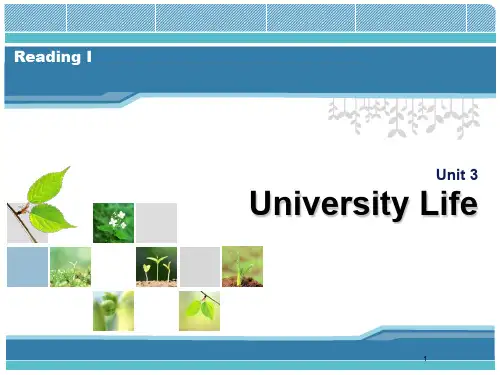
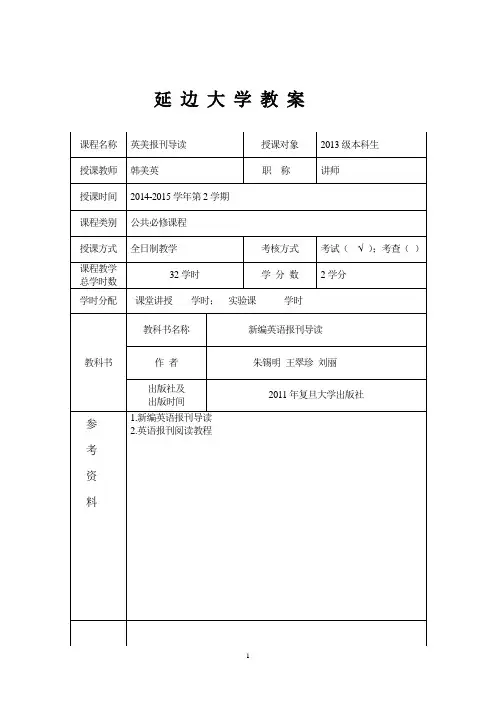
目录第1单元社会群体1.Who We Are Now?(当今美国种族成分)知识介绍:移民之国语言简说:报刊英语特色2.The Lost Generation(迷惘的一代)知识介绍:内战后的几代人语言简说:美国社会群体相关词语3.The Year of the(Business)Woman(妇女企业家的从政之年)知识介绍:美国妇女地位语言简说:《美国新闻与世界报道》简介4.Think Again:Global Aging(全球老龄化问题的重新思考)知识介绍:全球人口老龄化语言简说:委婉语第2单元家庭婚姻5.Dating and Mating for Over-35s(大龄青年恋爱与结婚)知识介绍:英美大龄末婚现象语言简说:标题修辞6.Working at Home: Family-friendly?(在家办公是否有益家庭生活?)知识介绍:家庭与工作关系语言简说:标题常用符号7.The Future of Abortion(堕胎问题的发展前景)知识介绍:美国妇女堕胎问题语言简说:《新闻周刊》介绍8.The War over “Family Values”(家庭价值观的论战)知识介绍:美国单亲家庭语言简说:报刊用喻第3单元文教娱乐9.Me Me Media(个性化的媒体)知识介绍:Web 2.0:一场新的网络变革语言简说:《读者文摘》简介10.Reining in the Test of Tests(严控高考题型)知识介绍:高校招生语言简说:新闻标题的结构11.Plot Claange:Foreign Forces Tr aforin HollywoodFilms(改变好莱坞电影的外国因素)知识介绍:美国电影全球化策略语言简说:词语+er构词12.Get Moving!(动起来!)知识介绍:健康与锻炼语言简说:《时代》周刊介绍第4单元衣食住行13.The Decline of Neatness(行为标准的蜕化)知识介绍:美国人的穿着语言简说:闲适性评论语言特色14.The Deadly Noodle(~命的饮食)知识介绍:饮食与肥胖语言简说:词语文化内涵15.Thrown Together in a Crisis,Strange Share Ca and LifeStories(危难时拼车相聚,陌生人亲切交谈)知识介绍:纽约公交罢工语言简说:《纽约时报》简介16.“Exurbs”Floudsh,but Is This Really What WeWant?(城市远郊扩张,是否符合愿望?) 【2版1单元L4】知识介绍:城市无序扩张语言简说:拼缀词第5单元观念风尚17.How Anglo Is America(美国特性中有多少英国文化成分)知识介绍:英国文化对美国文化影响深远语言简说:派生构词18.Economic Downturn Has More Folks Stashing TheirCash(经济衰退促使更多人存款)知识介绍:美国人消费观的变化语言简说《今日美国报》简介19.Do the Elderly Want to Work?(老年人想干工作吗?)知识介绍:美国退休问题语言简说:报刊常用俚语20.Regular Folks Get the Star Treatment(普通人享受日月星待遇)知识介绍:美国人爱美容语言简说:特写常用导语第6单元政治体制21.Who's Sorry Now?(是谁在难受?)知识介绍:游说活动语言简说:词性转化22.What Deep Throat did(“深喉”到底做了什么?)知识介绍:水门事件语言简说:新闻报道引语23.The Neocon Revolution(新保守主义革命)知识介绍:新保守主义语言简说:报刊翻译常见错误24.Ever Higher Society,Ever Harde r to Ascend(社会阶梯越来越高,地位攀升越来越难)知识介绍:美国阶级状况语言简说:词义变化第7单元企业经济25.E-Biz Strikes Again!(电子商务再次袭击)知识介绍:电子商务语言简说:网络新词常用词缀26.Why the Dollar's Reign Is Near an End(美元统治地位缘何即将结束)知识介绍:美元地位语言简说:习语活用27.The Grapes of wrath,Again(“愤怒的葡萄”情景再现)知识介绍:美国非法移民语言简说:报刊常用典故28.The Changing Face of American Jobs(美国就业市场的变化)知识介绍:美国劳力市场结构变化语言简说:复合词第8单元科技军事29.GPS NaVigation Moves to Your Pa lm(全球定位系统装置进入手中)知识介绍:GPS的前世今生语言简说:名词定语30.Medicine's Wild Kingdom(生物医学的王国)知识介绍:生物制药语言简说:前置定语31.Power Revolution(能源革命)知识介绍:再生能源语言简说:缩略词32.Cadets Trade the Trenches for F irewalls(军校学员的网络战演习)知识介绍:网络战语言简说:标题短词第9单元社会问题33.The Other America(美国的另外一面)知识介绍:卡特里娜飓风语言简说:嵌入结构34.In Congress,the Uphill Battle for Gun Control(国会限枪之战难以取胜)知识介绍:枪支问题语言简说:外刊与文化35.Should Drugs Be Legalized?(毒品应该合法化吗?)知识介绍:美国吸毒问题语言简说:称号、职务前置36.Homeless U.S.A(美国的无家可归问题)知识介绍:美国住房情况语言简说:解释性报道第10单元世界风云37.Three Lessons from London(伦敦爆炸案的教训)知识介绍:恐怖主义语言简说:借代38.After the Flames(骚乱平息后的反思)知识介绍:移民问题语言简说:“说”意动词39.The Weakest Link(世界最弱的环节)知识介绍:伊拉克战争语言简说:外报外刊中意识形态的表现40.Fight for the T0p of the World(北极之争)知识介绍:北极之争语言简说:版面与图片。
英语新闻报刊阅读教程吴一峰课后答案1、What did you _______ at the meeting yesterday? [单选题] *A. speakB. tellC. say(正确答案)D. talk2、He kept walking up and down, which was a sure()that he was very worried. [单选题] *A. sign(正确答案)B. characterC. natureD. end3、You have been sitting on my hat and now it is badly out of(). [单选题] *A. dateB. shape(正确答案)C. orderD. balance4、I hope to see you again _______. [单选题] *A. long long agoB. long beforeC. before long(正确答案)D. long5、____ wants to see you. [单选题] *A. Somebody(正确答案)B. AnybodyC. All the peopleD. No people6、—What’s the matter with that boy?—______.()[单选题] *A. He is watching TV in his roomB. He takes his temperatureC. He was playing a toy carD. He hurt his right leg(正确答案)7、A healthy life is generally thought to be()with fresh air, clean water, and homegrown food. [单选题] *A. joinedB. boundC. lackingD. associated(正确答案)8、Alice is a ______ girl. She always smiles and says hello to others.()[单选题] *A. shyB. strictC. healthyD. friendly(正确答案)9、87.—Could you? ? ? ? ? ? me the way to the nearest hospital?—Sure. [单选题] *A.askB.tell(正确答案)C.talkD.speak10、At nine yesterday morning, I ______ an English class while they ______ a PE class.()[单选题] *A. was having; were having(正确答案)B. had; hadC. was having; hadD. had; were having11、If the manager had to choose between the two, he would say John was _____ choice. [单选题] *A. goodB. the bestC. betterD. the better(正确答案)12、John had planned to leave, but he decided to stay in the hotel for()two days because of the heavy rain. [单选题] *A. otherB. the otherC. another(正确答案)D. others13、Sam is going to have the party ______ Saturday evening. ()[单选题] *A. inB. on(正确答案)C. atD. to14、33.Body language is even___________ and ___________ than any other language. [单选题] *A.stronger, loudB.strong, louderC.strong, loudD.stronger, louder (正确答案)15、Medicines are to be taken according to the doctor’s advice. [单选题] *A. 发放B. 提取C. 配方D. 服用(正确答案)16、I usually do some ____ on Sundays. [单选题] *A. cleaningsB. cleaning(正确答案)C. cleansD. clean17、It was _____ that the policy of reform and opening up came into being in China. [单选题] *A. in the 1970s(正确答案)B. in 1970sC. in the 1970s'D. in 1970's18、18.Who is staying at home now? ________, all of them are out. [单选题] * A.NoneB.No one(正确答案)C.EveryoneD.Nothing19、55.There is a ________ on in the bookshop. Let's go to buy some books. [单选题] * A.movieB.matchC.sale(正确答案)D.concert20、_____ whether robots will one day have vision as good as human vision. [单选题] *A. What is not yet knownB. It is not yet known(正确答案)C. As is not yet knownD. This is not yet known21、Leave your key with a neighbor ___ you lock yourself out one day [单选题] *A. ever sinceB. even ifC. soon afterD. in case(正确答案)22、E-mail is _______ than express mail, so I usually email my friends. [单选题] *A. fastB. faster(正确答案)C. the fastestD. more faster23、Be _______ when you are driving. [单选题] *A. afraidB. careful(正确答案)C. clearD. clean24、39.__________ he was very tired, he didn’t stop working. [单选题] * A.Although (正确答案)B.WhenC.AfterD.Because25、In winter, animals have a hard time_____anything to eat. [单选题] *A.to findB.finding(正确答案)C.foundD.to finding26、Yesterday I _______ a book.It was very interesting. [单选题] *A. lookedB. read(正确答案)C. watchedD. saw27、—Is this Tony’s history book?—No, it isn’t ______.()[单选题] *A. himB. his(正确答案)C. heD. himself28、While my mother _______ the supper, my father came back. [单选题] *A. cooksB. is cookingC. was cooking(正确答案)D. has cooked29、Was()that I saw last night at the concert? [单选题] *A. it you(正确答案)B. not youC. youD. that yourself30、Mrs. Green has given us some _______ on how to study English well. [单选题] *A. practiceB. newsC. messagesD. suggestions(正确答案)。